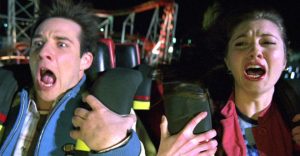Alfred Hitchcock: His 10 Best Cameos, Ranked

There are two distinct periods in Alfred Hitchcock’s filmography. There is his earlier British period and his later 28-film American period (movies such as Under Capricorn, Stage Fright, and Frenzy are British films). The American period started with Rebecca in 1940. From that period on, Hitchcock made a cameo appearance in nearly all of his films.
While Hitch made intermittent walk-on appearances in his earlier films, it became more of a treat for fans as his career went on. Usually, he’d just walk by the camera, sometimes holding a musical instrument, sometimes empty-handed. The best bit parts found a way to change things up, with some cameos being more memorable than others.
Looking Back At The Lead In Stage Fright (1950)

Stage Fright follows actor Jonathan Cooper as he’s accused of murder. Taking shelter in the home of his ex-girlfriend, Eve, he stands by his claim that his lover is actually the murderer. Eve believes him and investigates, but she may find more than she can handle.
Hitchcock appears about 40 minutes in the movie, looking back at Eve as she’s out practicing her undercover role. He has a look of skepticism, which certainly matches the tone of someone acting outside of their norm.
Boarding A Bus In North By Northwest (1959)

The plot of this frequently-imitated Hitchcock movie follows Cary Grant’s Roger Thornhill in a case of mistaken identity. Phillip Vandamm (James Mason, giving a classic performance) believes him to be a secret agent and, before long, Thornhill is on the run from gun-wielding, plane-flying henchmen.
A lot of Hitchcock’s walk-on roles came early in the movie, so as not to have audiences focused on his potential appearance over the plot. In North by Northwest, he appears two minutes in, with the scene depicting him missing his bus. It just seems like Hitchcock was having fun with this cameo.
With A Double Bass Case In Strangers On A Train (1951)

Strangers on a Train follows amateur tennis star Guy Haines, who wants to divorce his wife in favor of another woman. While on a train, he meets Bruno Antony, who reveals his idea of two strangers killing the other’s would-be victim. Haines is polite but Antony is, unfortunately, quite serious.
About 10 minutes into the film, Hitchcock is seen passing Haines as he hops off a train. Hitch is holding a double bass and nearly bumps into the film’s protagonist.
Not A Fan Of Clapping In Frenzy (1972)

Frenzy, the director’s second-to-last film, takes place in a panic-stricken London. A serial killer is on the loose. His trademark: murder using a necktie. Ex-Royal Air Force officer Richard Blaney is accused of his ex-wife’s murder. He goes on the run and ends up in the home of his best friend. However, his buddy may be more than he seems.
This underrated Alfred Hitchcock movie featured an appearance from the director less than three minutes in. He’s also technically in a couple of shots. He can be seen in a long shot, then there’s the main shot of him definitively not applauding a speech, and again about a minute later.
Sitting Next To Cary Grant (And A Bird) In To Catch A Thief (1955)

The plot of To Catch A Thief follows retired burglar John Robie (Cary Grant) as he attempts to clear his name on a string of copycat thefts.
Early on in To Catch A Thief, Robie is shown sitting in the back row of a bus. Sitting next to him is Hitchcock himself, looking stoic as always. Also next to Robie is a cage with two birds, perhaps as a sort of foreshadowing for a later Hitchcock movie.
Giving Off The Shining Vibes In Dial M for Murder (1954)

Dial M for Murder is both one of Grace Kelly’s best movies, as well as just one of three collaborations with Hitchcock (the others being Rear Window and To Catch A Thief). It follows the wealthy Margot (Kelly), wife of an ex-tennis pro. He wants to have her killed to gain access to her inheritance but, naturally, the plan goes off the rails.
About 13 minutes in, a class-reunion photo is held up to the camera. Hitchcock is shown very plainly sitting close to Wendice and Swan. It’s an interesting addition to his line of appearances as it goes a little against the established grain of walking by the camera.
Still Behind A Camera In Young And Innocent (1937)

Young and Innocent follows Robert Tisdall, a man who is accused of murdering an actress after finding her body. He teams up with the daughter of the police chief to discover the true identity of the killer.
Exactly 15 minutes in, Hitchcock is seen standing outside of a courthouse holding a camera. He’s playing a journalist, one of several. The charm of this role is the fact that the director still manages to find a way to step behind a camera.
Walking Out Of A Pet Shop In The Birds (1963)

The plot of The Birds follows Melanie Daniels (Tippi Hedren, who once played mother to her real-life daughter) as she pursues Mitch Brenner, a man she just met in a pet shop. Brenner mentioned his sister’s upcoming birthday, so Daniels travels out with a pair of lovebirds. Then, a gull attacks her. Before long, seemingly every bird on the planet is on the attack.
Hitchcock’s charming spot comes very early in The Birds. About two minutes in, Hitch is seen exiting the pet shop Daniels is entering. In his hands are the leads to his two Sealyham terriers. The fact that the dogs were actually his makes the appearance even more charming.
On A Newspaper In Lifeboat (1944)

The plot of this micro-cast film follows the few survivors of a German submarine’s attack on an American freighter. This group of American and British civilians attempts to reach land on a lifeboat. After a German officer is rescued from the water, the whole group becomes distrusting, and, before long, the lifeboat’s rate of occupancy decreases.
Nearly a half-hour into Hitchcock’s underrated Lifeboat, Gus Smith holds up a newspaper. On it is an ad for “Reduco Obesity Slayer.” Hitchcock is the model for the before and after pictures.
Holding A Baby In Torn Curtain (1966)

Paul Newman plays physicist Michael Armstrong in one of Hitchcock’s final films, Torn Curtain. Armstrong is a spy who seemingly defects to the Soviet Union during the Cold War. He’s in fact a double agent, and before long he and his fiancée (Julie Andrews) are on the run from the Soviets.
Less than 10 minutes into Torn Curtain, the legendary auteur is seen in the lobby of the Hotel d’Angleterre. On his lap, a baby. It’s a cameo that shows a gentler side to the man who once directed Psycho.
About The Author


















